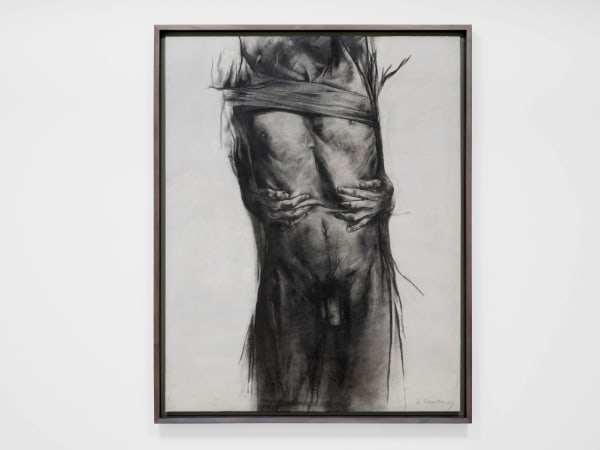-
Luis Caballero: A deliberate defiance
9 January - 9 February 2024 -
Essay by Bella KesoyanThe first posthumous solo presentation of the work of Colombian artist Luis Caballero (1943-1995) in Britain introduces the viewer to the artist’s drawing practice in the last two decades of his life. Curated by Daniel Malarkey in collaboration with Cecilia Brunson Projects, the exhibition A deliberate defiance showcases not only the mastery of the artist’s line and draughtsmanship, but also his unparalleled ambition in creating his own visual language.
-
 Luis Caballero, Untitled, 1979, mixed media on paper, 128 x 158 cm (50 3/8 x 62 1/4 in)
Luis Caballero, Untitled, 1979, mixed media on paper, 128 x 158 cm (50 3/8 x 62 1/4 in) -
-
Luis Caballero’s paintings are an epitome of living. For the artist, the body alone could carry the weight of all the emotions and struggles that the human soul experiences all the while it draws breath. The male body is to Caballero what words and sentences are to a poet – it is his preferred language, as it is the body that he worships, that he believes in, that he wants to communicate with and understand.Caballero does not make a distinction between a body that is his own and the one that belongs to another. When we look at his drawings, we are not looking at separate figures coming together in a carnal embrace or in strife. We are almost inspecting one and the same body over and over – the body of the artist and the body of his lover, the body of Christ, the body of every viewer who has ever succumbed to the agony of love. Caballero’s bodies have no faces – they are the artist’s reflection in the mirror, but they are also ours.
-
 Luis Caballero, Untitled, 1979, charcoal on paper laid down on canvas, 158 x 128 cm (62 1/4 x 50 3/8 in)
Luis Caballero, Untitled, 1979, charcoal on paper laid down on canvas, 158 x 128 cm (62 1/4 x 50 3/8 in) -
And yet, there is discomfort there. Just as in the monumental canvases of Francis Bacon, whose work Caballero became familiar with and was drawn to very early in his life, the urge to look confronts the desire to avert the gaze. With this break from the traditional male gaze into a fearless, openly queer viewpoint begins a conversation about what is allowed and what is not, what is intimidating and what is not, what is comfortable because it is set within an expected and agreed cultural framework, and what is not.
-
Edward Lucie-Smith, the writer, poet and art critic, who has followed and written about Caballero’s career for many years, traced the footsteps of Francis Bacon in his art. He argued that the closeness Caballero felt to Bacon did not come only from their shared artistic language of the body, but was also rooted in Bacon’s openness about his sexuality at a time when being gay was criminal. Born and raised in Colombia, one of the most doctrinal Latin American societies, a society he himself called ‘fanatical’ and ‘violent,’ Caballero grew up surrounded by a paradoxical abundance of the visual representation of male nude as an instrument of the Church, in an environment that cultivated contempt and shame for the naked human body.
-
-
-
Caballero’s works in charcoal bring a sense of the poetry of the High Renaissance together with the open sexuality of Mannerism. Although he never touched a chisel, Caballero’s drawings contain the angst of Bernini’s Proserpina and the tenderness of Michelangelo’s Pietà (1498-99). Through precise lines and soft shadows, he brings out the plasticity of the form, while the dissection of bodies by the paper’s edge allows him to evade certainty in favour of abstraction. The medium of drawing allows the artist to speak more directly to the viewer, to be less realistic while at the same time more authentic. In his own words, Caballero strived “to draw an emotion, not an image of an emotion; to achieve an image where pain, beauty, pleasure and horror coexist; to create an image that is real without being descriptive; to reach the divine without losing humanity”.
-
Caballero lived and worked in Paris for more than 25 years from 1968 to his untimely death from AIDS in 1995. He was one of the few Latin American artists of the time to be completely frank about his sexuality both before and after his relocation to France. The epidemic was particularly severe in France in comparison to other European countries, and living through the severity of it, being part of the community permanently reshaped by its calamity, required the kind of courage and sincerity that allowed the artist to imbue his paintings with so much life. Caballero’s depiction of the triumph of survival, of love and defiance leaves the viewer with their own courage to feel in the most genuine way and to allow themselves to be lost within his world.
-
 Luis Caballero, Untitled, 1979, charcoal on paper laid down on canvas, 118 x 151 cm (46 1/2 x 59 1/2 in)
Luis Caballero, Untitled, 1979, charcoal on paper laid down on canvas, 118 x 151 cm (46 1/2 x 59 1/2 in)





